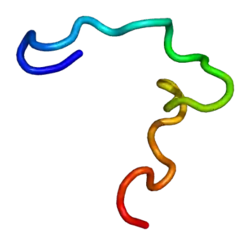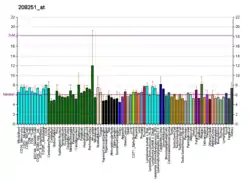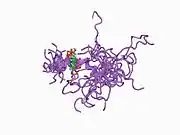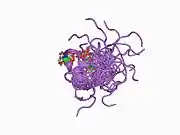KCNC4
Potassium voltage-gated channel, Shaw-related subfamily, member 4 (KCNC4), also known as Kv3.4, is a human gene.[5]
The Shaker gene family of Drosophila encodes components of voltage-gated potassium channels and comprises four subfamilies. Based on sequence similarity, this gene is similar to the Shaw subfamily. The protein encoded by this gene belongs to the delayed rectifier class of channel proteins and is an integral membrane protein that mediates the voltage-dependent potassium ion permeability of excitable membranes. It generates atypical voltage-dependent transient current that may be important for neuronal excitability. Several transcript variants encoding different isoforms have been found for this gene.[5]
See also
References
- GRCh38: Ensembl release 89: ENSG00000116396 - Ensembl, May 2017
- GRCm38: Ensembl release 89: ENSMUSG00000027895 - Ensembl, May 2017
- "Human PubMed Reference:". National Center for Biotechnology Information, U.S. National Library of Medicine.
- "Mouse PubMed Reference:". National Center for Biotechnology Information, U.S. National Library of Medicine.
- "Entrez Gene: KCNC4 potassium voltage-gated channel, Shaw-related subfamily, member 4".
Further reading
- Gutman GA, Chandy KG, Grissmer S, et al. (2006). "International Union of Pharmacology. LIII. Nomenclature and molecular relationships of voltage-gated potassium channels". Pharmacol. Rev. 57 (4): 473–508. doi:10.1124/pr.57.4.10. PMID 16382104.
- Vega-Saenz de Miera E, Moreno H, Fruhling D, et al. (1992). "Cloning of ShIII (Shaw-like) cDNAs encoding a novel high-voltage-activating, TEA-sensitive, type-A K+ channel". Proc. Biol. Sci. 248 (1321): 9–18. doi:10.1098/rspb.1992.0036. PMID 1381835.
- Ghanshani S, Pak M, McPherson JD, et al. (1992). "Genomic organization, nucleotide sequence, and cellular distribution of a Shaw-related potassium channel gene, Kv3.3, and mapping of Kv3.3 and Kv3.4 to human chromosomes 19 and 1". Genomics. 12 (2): 190–6. doi:10.1016/0888-7543(92)90365-Y. PMID 1740329.
- Rudy B, Sen K, Vega-Saenz de Miera E, et al. (1991). "Cloning of a human cDNA expressing a high voltage-activating, TEA-sensitive, type-A K+ channel which maps to chromosome 1 band p21". J. Neurosci. Res. 29 (3): 401–12. doi:10.1002/jnr.490290316. PMID 1920536.
- Covarrubias M, Wei A, Salkoff L, Vyas TB (1995). "Elimination of rapid potassium channel inactivation by phosphorylation of the inactivation gate". Neuron. 13 (6): 1403–12. doi:10.1016/0896-6273(94)90425-1. PMC 2211371. PMID 7993631.
- Beck EJ, Sorensen RG, Slater SJ, Covarrubias M (1998). "Interactions between multiple phosphorylation sites in the inactivation particle of a K+ channel. Insights into the molecular mechanism of protein kinase C action". J. Gen. Physiol. 112 (1): 71–84. doi:10.1085/jgp.112.1.71. PMC 2229409. PMID 9649584.
- Strausberg RL, Feingold EA, Grouse LH, et al. (2003). "Generation and initial analysis of more than 15,000 full-length human and mouse cDNA sequences". Proc. Natl. Acad. Sci. U.S.A. 99 (26): 16899–903. doi:10.1073/pnas.242603899. PMC 139241. PMID 12477932.
- Angulo E, Noé V, Casadó V, et al. (2005). "Up-regulation of the Kv3.4 potassium channel subunit in early stages of Alzheimer's disease". J. Neurochem. 91 (3): 547–57. doi:10.1111/j.1471-4159.2004.02771.x. PMID 15485486.
- Gerhard DS, Wagner L, Feingold EA, et al. (2004). "The status, quality, and expansion of the NIH full-length cDNA project: the Mammalian Gene Collection (MGC)". Genome Res. 14 (10B): 2121–7. doi:10.1101/gr.2596504. PMC 528928. PMID 15489334.
- Abbott GW, Butler MH, Goldstein SA (2006). "Phosphorylation and protonation of neighboring MiRP2 sites: function and pathophysiology of MiRP2-Kv3.4 potassium channels in periodic paralysis" (PDF). FASEB J. 20 (2): 293–301. doi:10.1096/fj.05-5070com. PMID 16449802.
- Gregory SG, Barlow KF, McLay KE, et al. (2006). "The DNA sequence and biological annotation of human chromosome 1". Nature. 441 (7091): 315–21. doi:10.1038/nature04727. PMID 16710414.
This article incorporates text from the United States National Library of Medicine, which is in the public domain.








